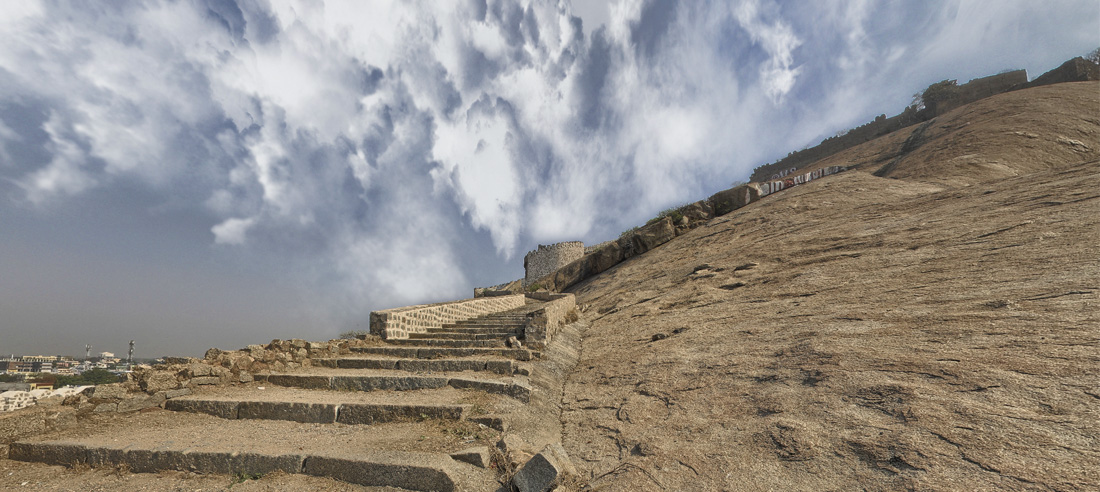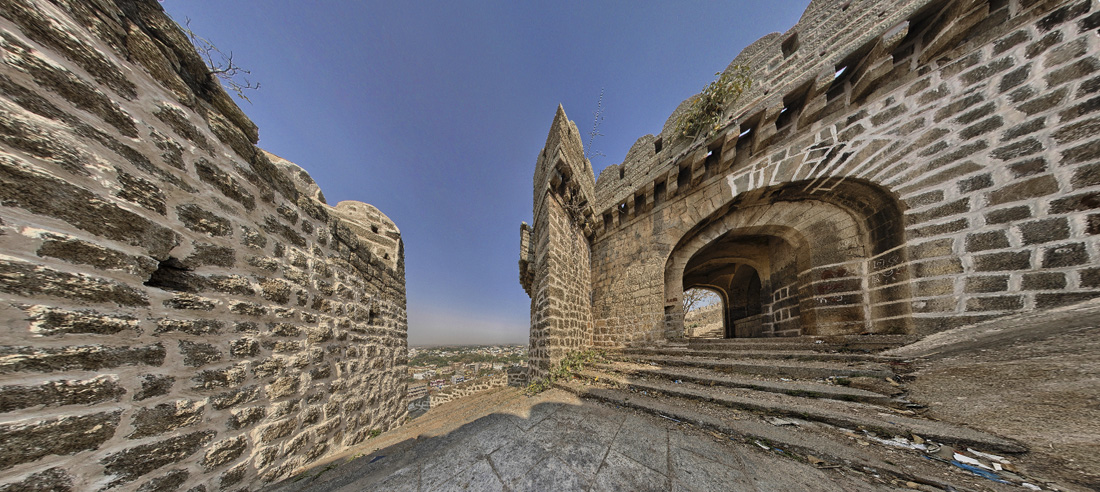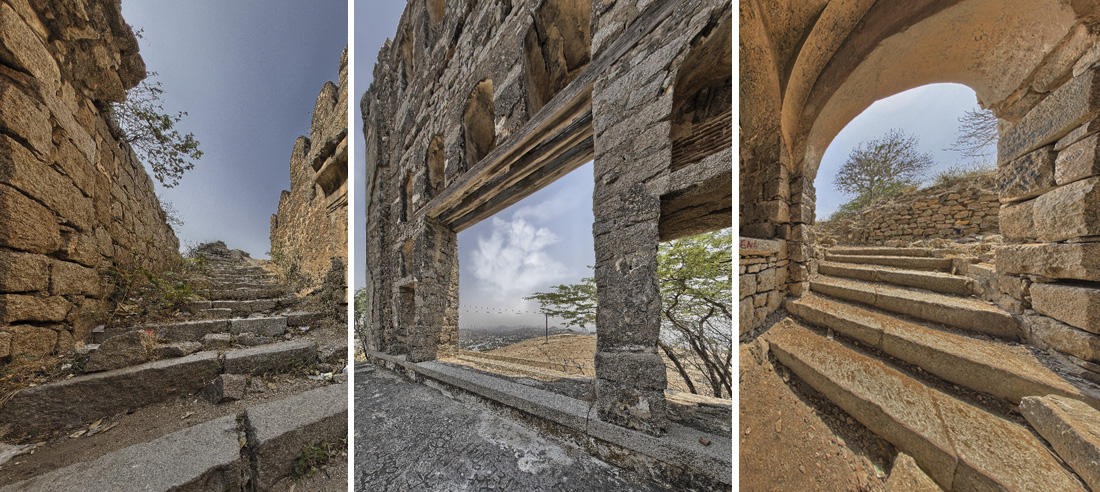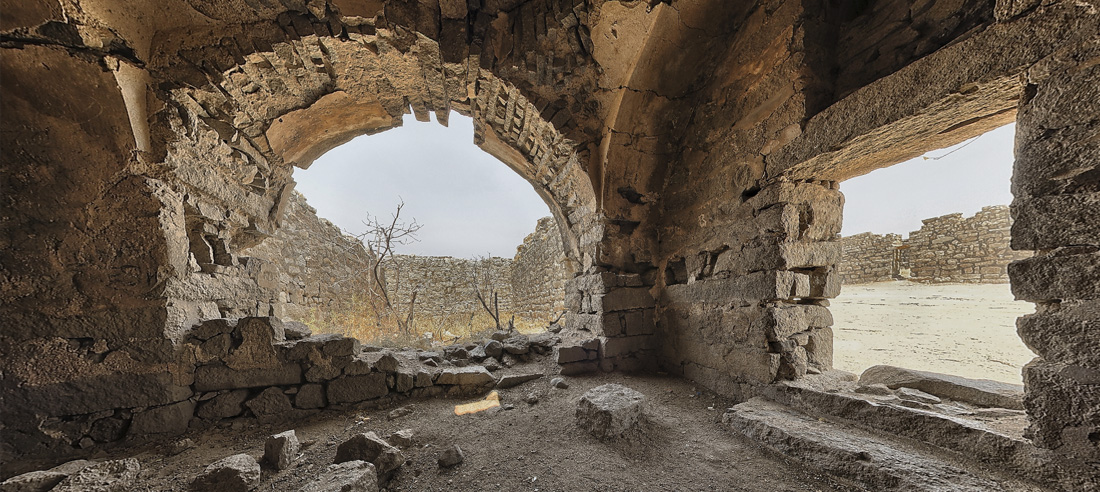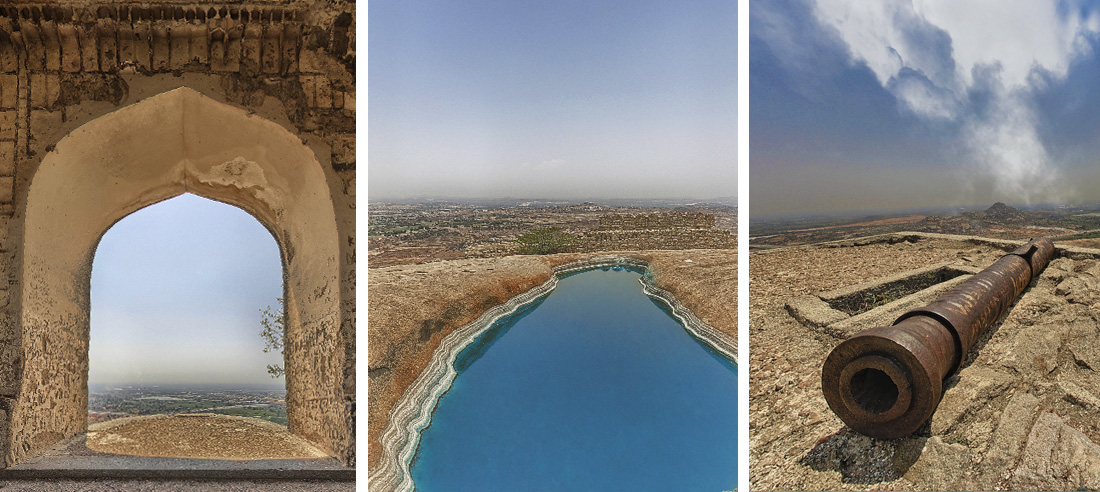Steps to Bhongir Fort
A monolithic rock structure, seemingly impossible architectural design are the first impressions that you would be getting when you visit this magnificent structure, the Bhongiri Fort. The Bhongiri Fort is located in the Bhuvanagiri muncipality of Nalgonda district of Telangana, India. It greets you with a 1000 year old history. The Bhongiri Fort has stood the ravages of time and has been a very important place during the famous Kakatiyan rule. It was later occupied by the Qutub Shahi Sultans and is now mixed with the Indo-Islamic heritage.
The fort is open to the general public and can be reached through a steep set of stairs up the hill and a lot of adventure impulse. It is now in sad ruins that convey the long history of time! There are two entrances and the one you are seeing right now is one of them and the one that is commonly used.
Bhongir Fort Entrance
A massively impregnable structure, the Bhongiri Fort has been constructed atop an egg like gigantic monolithic rock, 610 meters above the sea level. It has been constructed to stop the invading armies and it seems that this structure has pretty much done the job. The view from the top of the surrounding countryside can be impressive, as you can see. The fort is associated with the rule of queen Rudramadevi and her grandson Prataparudra.
Grand Entrance of Bhongir Fort
The Bhongiri Fort was originally constructed by the Kakatiya rulers in Circa 11th Century and is commonly associated with the rule of Rani Rudramadevi and her grandson Prataparudra. Its magnificent architecture prevented invading armies to capture it. However, with the advent of gun powder and cannons, the fort was ceased by the Bahmani Sultans, who later renovated it to their taste. This has probably resulted in the shift of the true history of the fort. Although we cannot categorize the architecture in the present day, we can simply say that the Bhongiri Fort is of Indo-Islamic architecture model.For the sad reason of being in complete ruins, there is very little known about any specific spot.
An Arched Barbican in the Fort
The fort is now in complete ruins and one can just have a look in awe at the construction marvel that has been achieved some 1000 years ago. It is said that post the conquer of the fort by the Bahmani Sultans, they made it the seat of the local governor, and a prison for the pretenders of the Qutub Shahi throne. By the fall of the 18th Century, the history and the fort has fallen into ruins and until recent times, it remained a calm ruin of a once magnificent fort, mossed up in its ancient and enigmatic past.
The Majestic Fort
Although trekking up the Bhongiri Fort can be truly one of the most unforgettable experiences, there is always a hollowness that speaks to you to search for the history that it is entangled in. You cannot possibly understand more about the architectural model, the importance of the fort spots and the ruins leave you with a tinge of melancholy.
Archways in Bhongir Fort
The splendid historical fort with the awe-inspiring rock and the aesthetically fortified courts which have stood the ravages of time stir the imagination of tourists. A moat that encircles the fort, a vast underground chamber, trap doors, an armoury, stables, ponds, wells etc., can make interesting viewing. The view from the top of the surrounding countryside can be impressive. The Bala Hisar or citadel on the top of the hill gives a bird’s eye view of the neighbouring area. The fort is associated with the rule of queen Rudramadevi and her grandson Prataparudra.
Graffiti of Negligence !!
The fort is now in complete ruins and one can just have a look in awe at the construction marvel that has been achieved some 1000 years ago. It is said that post the conquer of the fort by the Bahmani Sultans, they made it the seat of the local governor, and a prison for the pretenders of the Qutub Shahi throne. By the fall of the 18th Century, the history and the fort has fallen into ruins and until recent times, it remained a calm ruin of a once magnificent fort, mossed up in its ancient and enigmatic past. The Bhongiri Fort is now in complete isolation from all the legends that may have once existed. We have tried quite a few people to trace back some history and related to the fort but to vain. There are no legends today, there is no interest towards carrying the history that it may have once boasted. It is a not just a physical ruin but a complete one.
A massively impregnable structure, the Bhongiri Fort has been constructed atop an egg like gigantic monolithic rock, 610 meters above the sea level. It has been constructed to stop the invading armies and it seems that this structure has pretty much done the job. The Bala Hisar or citadel on the top of the hill gives a bird’s eye view of the neighbouring area, which possibly is this structure.
Bhongir Fort was built on an isolated monolithic rock by the Western Chalukya ruler Tribhuvanamalla Vikramaditya VI and was thus named after him as Tribhuvanagiri. This name gradually became Bhuvanagiri and subsequently Bhongir. At the foot of the fortified rocks 609.6 meters above the sea level stands the town of Bhongir, it has a unique egg-shaped construction with two entry points protected by huge rocks, so the fort was considered practically impregnable by invading armies.
The splendid historical fort with the awe-inspiring rock and the aesthetically fortified courts which have stood the ravages of time stir the imagination of tourists. A moat that encircles the fort, a vast underground chamber, trap doors, an armoury, stables, ponds, wells etc., make for interesting viewing. The view from the top of the surrounding countryside can be impressive.
This the closest that you can get to any legend concerning the Bhongiri Fort at present. In a book, “Hyderabad 400 glorious years”, written by K.Chandraiah, he states the following:
Sultan Quli Qutub-ul-Mulk (1493-1543) who was the first king of Qutub Shahi dynasty imprisoned his son Dowlat Quli in this fort as a state prisoner. Dowlat Quli was posing threat to his father’s rule, so he was imprisoned to avoid country being eventually plunging into tumult and confusion. He was stigmatised as “mad prince” for his foolish and immoral acts verging on disloyalty. Another son
Jamsheed Quli was confined to Golconda Fort. Later Jamsheed Quli comes to power by killing his own father, but Dowlat Quili died as a prisoner inside the fort.
A detailed tour of the fort shall leave you gasped with the fact that it is highly equipped with all the comforts, although now not in visibility. The rock on which the fort is built stands at an average height of 430 meters and spans almost 40 acres, a considerable size! As is visible here, this is one of the pools that situated on the fort area. There are wells, underground chambers, stables and more in the fort area to add to all the mystical pulse surrounding the fort.
The Canon at Bhongir Fort
A cannon up the fort hill. Everything arises questions on the area. How could someone build such a great structure up a 600 meter hill in the 11th century without much of a technical assistance?
Also visible is a broadcasting station installed by the Government. Probably, this station is the only place up the hill that has some life breathing in it!

